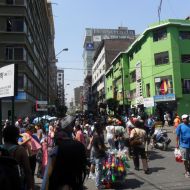Dispelling the Myth that “On Paper” Always Works Well on the Street
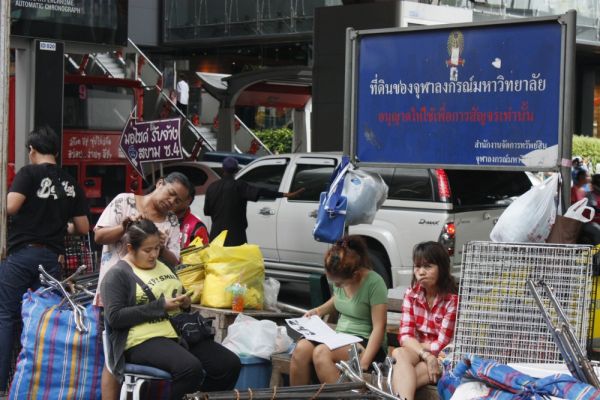
Traders relaxing next to a sign that declares: “[This] land is owned by Chulalongkorn University” and in red, for emphasis, “only traffic is allowed.”
At 4 p.m., on the wide concrete footpath of Siam Square, next to a busy arterial road, several street traders sit on collapsible stools, chatting with their neighbors and playing with their phones. They have not yet set up their stalls, and so the stream of people strolling by pays them minimal attention. Without their pirated DVDs and cheap dresses on display, they might as well be invisible.
Two hours later, however, these vendors are providing the backbeat to the thumping pulse of Siam Square as the sidewalk transforms into a full-fledged marketplace, bustling with shoppers and onlookers. DIY-style market stalls, a few hundred of them, entice bargain hunters and impulse buyers with their motley merchandise. Clothing racks are strung with women’s clothes, t-shirts and light bulbs. Some of the vendors have even brought their own mannequins, donning banal tags that boast “only 200 Baht” and “50% off.” For foreign visitors, the scene is a charming kind of chaos, an urban adventure.
Not everyone appreciates the congestion, however. For local commuters, the illegal street market is a routine chaos that only exacerbates an already onerous evening rush hour. As it happens, vendors prefer to locate themselves where pedestrian traffic is heaviest. In Siam Square, that means next to the stairways that connect the street to the massive elevated platform of Bangkok’s Skytrain, which runs along the arterial road of Rama I.
A few years ago, calls to “reclaim” the footpath were made to the landowner, Chulalongkorn University. In response, a coalition of respectable institutions was put together to try to relocate the vendors to a nearby venue. The traders refused, and the negotiation soon turned into a battle. Tens of millions of Baht were spent on anti-encroachment equipment and security personnel, according to Dr. Nantawat Boramanand, a widely respected professor of public law.
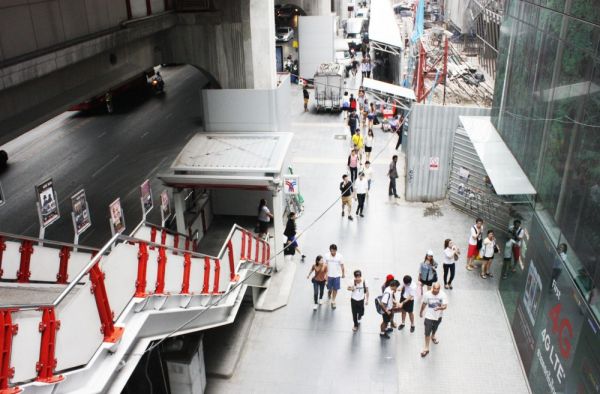
The view from the Siam Skytrain platform, 12 meters off the ground. Neatly uniformed students and tourists in tank-tops and t-shirts walk easily along the sidewalk.
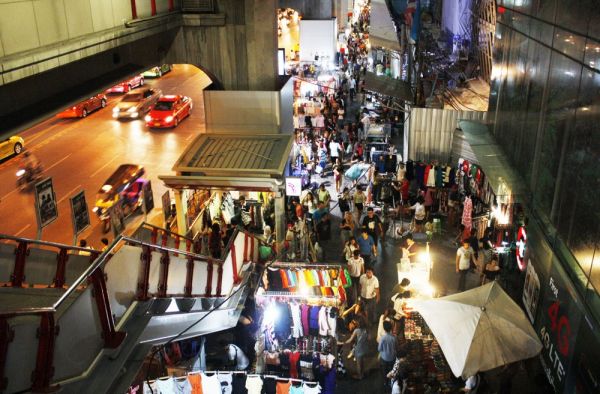
The same scene, a few hours later.
“I wouldn’t have done that if I were them,” says Peerasak, a street trader who was nominated as a representative to attend formal meetings during the negotiation. “[They] didn’t understand the implications of their actions.”
Though the battle lasted eight months, all the efforts by the authority proved to be futile. The traders showed resilience and solidarity and eventually won their right to stay on the street.
“[The vendors] even threatened to throw scorching oil [used for frying meat in their stalls] at our staff,” said Prof. Nantawat in a newspaper interview. But he also suggested that the coalition’s front-line personnel have not carried out their duties properly, and that other institutions, such as the police department and the local district office, did not cooperate. “This is an utter defeat for law enforcement,” he said. “This lax attitude that pervades the whole public sector needs to be improved.”
Thus, for the authority, the street market remains an inimical and uncontrollable chaos, one that they cannot hope to defeat only with rule of law.
Peerasak points to a simple truth that illustrates the complexity of the issue. “When the inspectors take off their uniforms,” he says, “they also buy food from street vendors.” It is almost a case of duty versus desire. “I know this city inspector whose nephew is a street vendor at Victory Monument.” He cites several other cases of such blurred lines.
“Although I didn’t graduate from a prestigious university abroad,” Peerasak continues, “[my experience] is more crystalized and I can see clearly what should be done to solve the problem.” A burly but approachable man, Peerasak quit his formal job as a salesperson at Armani Exchange six years ago to join the street scene full-time. He was chosen as a representative for the vendors partly because he is a natural leader who has earned respect for helping other vendors out of difficult situations. Moreover, with his polite but straightforward demeanor, it seems to me that he is better equipped to deal with their formal counterparts than most others. It is probably more true to say that the vendors are not illegal but semi-legal—on paper they’re banned, but the authority tolerates them, and even accepts them in practice.
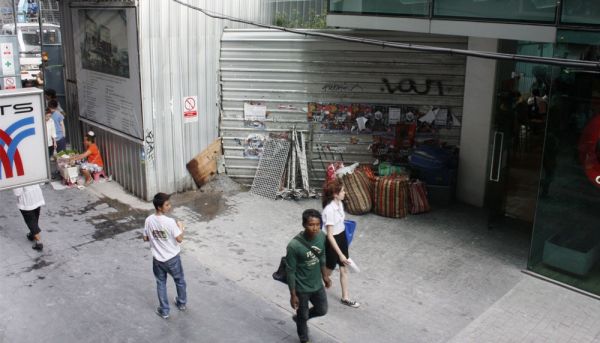
5:30 p.m. in Siam Square
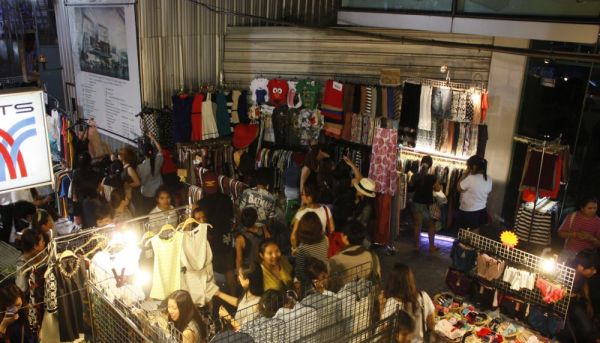
The same location at 10:30 p.m.
In hindsight, Peerasak suggests that the attempts to reclaim the sidewalk from vendors in Siam Square needn’t have been so heavy-handed and antagonistic. “They only said no, no, no,” he recalls. “They didn’t listen to us.” According to him the negotiations lacked sincerity, and promises to help were superficial. “As big institutions, they are more concerned with their image.”
“All of the vendors have agreed not to sell before six o’clock,” says Peerasak – who also acts as a liaison between the city inspectors and the traders – as opposed to last year, when the vendors occupied the footpath starting at noon. Peerasak also asked the vendors to make more space for pedestrians and they did. The new time management and control of the space go a long way as compromises.
“People tend to say that we are unorganized and uncooperative, but look at what happens on Monday.” Monday is designated as a citywide “rest day” for street traders.
Though the sidewalk congestion has somewhat improved, the compromises made by the vendors of Siam Square could be seen as efforts to co-opt the authority, so that they can continue profiting from the public space—if it gets too congested, they risk a backlash that pushes them out of the neighborhood altogether. Peerasak recognizes that the war between the authority and the vendors is not yet over. Though the crackdown three years ago resulted in a breakdown of trust, he’s hopeful for another round of negotiation.
“The vendors will not go away,” said Peerasak, emphasizing the need for a dialogue. “One hundred percent.”
Reflections on the Informal City Dialogues
“There are only patterns, patterns on top of patterns, patterns that affect other patterns. Patterns hidden by patterns. Patterns within patterns,” wrote Chuck Palahniuk in his novel Survivor. “What we call chaos is just patterns we haven’t recognized.” Likewise, what has happened and is happening on the sidewalk of Siam Square can be regarded as a microcosm—with patterns that get reproduced elsewhere—of informal Bangkok. “If you watch close, history does nothing but repeat itself.”
Though a casual observer of urban realities would associate “informality” with chaos, dirtiness and disorder, which by definition are bad and undesirable, experience from my work with the Informal City Dialogues strongly suggests otherwise. Unfortunately, the prevailing policy mentality seems to be that it is better for “the public” (are the poor not part of the public?) to get rid of the other half and put in place new structures and patterns – ones that at least appear more formal and conventional. But this is only an illusion of having done something to bring order into the world — an illusion that if you organize something on paper or hold lots of meetings, everything else will follow.
A city like Bangkok, like most other cities and societies I am sure, cannot afford not to have the informal. One way or another, the informal supports our modern lifestyles. More effort should be put into understanding, respecting and supporting the informal — an entity which is made up of little people doing little things, their own things. It is better to convince than control.
Photos by Witchaya Pruecksamars






